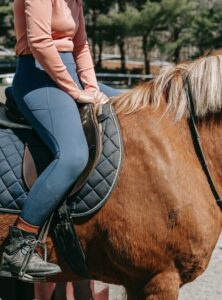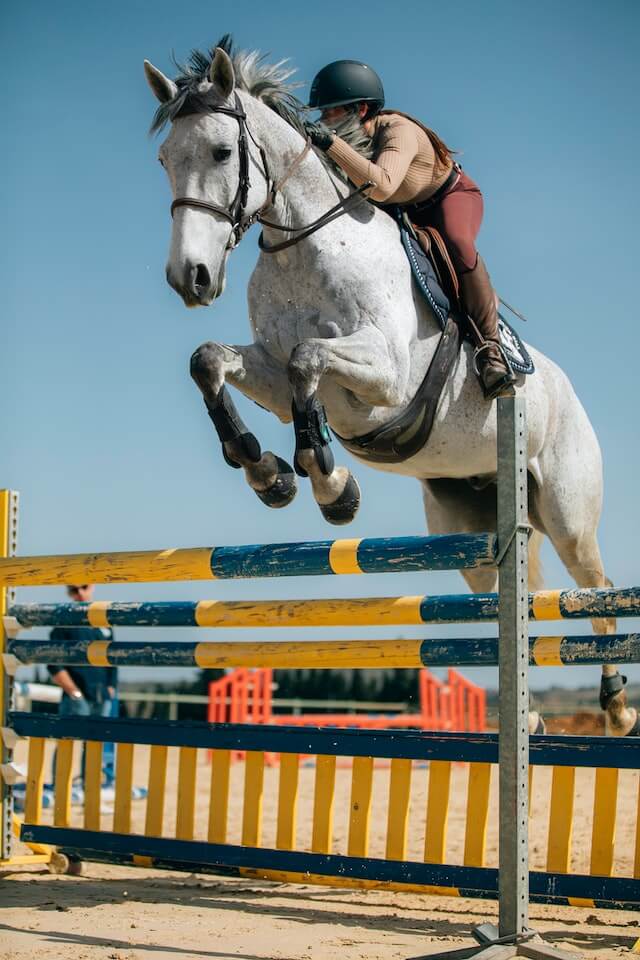This is especially true if they have dedicated their careers to trail riding or just one sport.
Don’t be alarmed if you think a dressage girth and thick looks unusual at first.
Why You Should Pay Attention to Girth Placement in Dressage
When properly worn, a human hand’s width should separate the end of the dressage girth from the horse’s elbow.
Depending on the horse’s structure, a varied girth position may be necessary to ensure comfort. Consult a saddle fitter for assistance if you experience difficulties with girth sizing and fitting.
Put your saddle on your horse, loosen the girth, and hand-walk them for a few minutes to find the girth groove. Thanks to the horse’s movement, the perimeter will slide into position.
Most horses dislike tightening their girths, making girth placement challenging.
Shane was a girth horse that I used to ride. He would pin his ears back when someone tightened his girth for a correct saddle fit.
The Dressage Girth Dilemma: Which Way is the Right Way?
The girth fastens to the saddle billets and encircles the horse’s abdomen. The buckles on the rim should be attached to hold the saddle securely.
Girths have a front and a back; therefore, it’s crucial to put one on facing the appropriate direction. Examining the perimeter’s center, which is situated between the horse’s front legs, is the most straightforward approach to determining location.
Here, most people will have a metal ring. Some people will have the ring just at the perimeter’s edge. It is simpler to understand this design. It is correct when the metal ring is situated closer to the horse’s front.
Other patterns are a little complex, and the metal ring is located more in the center. It is typically correct when the curved portion of the ring is pointing forward and lying comfortably.
Examining the girth’s shape can also help you decide if it is the correct way for this kind of design. The curve will be on one side. The perimeter is in the proper position when this curvature faces forward.
The straps on some girths are elastic.
Ensure the side with the adjustable straps is fastened to the left saddle billets if it only has elastic straps on one side. You must examine the metal ring and its shape if it has adjustable straps on both sides.
Not only is positioning crucial, but you must also ensure you’re using the correct size.
Figuring Out the Proper Dressage Girth Size for Your Horse

The girth should be the proper size for the dressage saddle to prevent rubbing and pinching.
There is elbow clearance, which permits freedom of movement and proper airflow and stops sweat from accumulating.
If you ride dressage, follow these instructions on correctly measuring a girth. First, mount your horse and attach the saddle and saddle pad without tightening the girth. Find the heart’s circumference next. Take a measuring tape, and place one end on the saddle billets’ second hole from the bottom.
With your free hand, take hold of the other side of the perimeter and wrap it around your horse’s heart girth, measuring it to the location of the second and third billet holes on the opposite side.
To get the proper dressage girth size for your horse, take note of the measurement from the tape measure—the heart girth—and multiply it by two before deducting it by three.
Why the Girth Matters: How it Affects a Horse’s Posture and Range of Motion
The perimeter impacts how the horse walks and how they carry themselves, which is a significant factor in the question of “where should take the girth rest on a horse.”
The muscles that enable lateral flexion and engagement of the front leg and hindquarters are pressed upon by an improper girth. Horses can move through their range of motion with the greatest dressage girths.
Conclusion
At the end of the day, it is important to understand how to utilize a dressage girth to ensure that your horse is comfortable at all times, whether it’s during dressage training or competitions.















